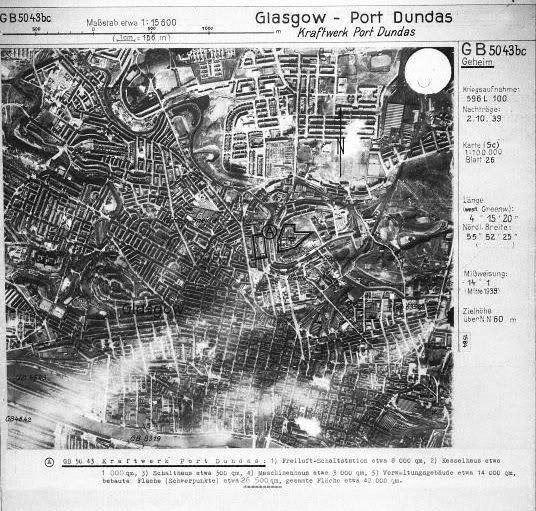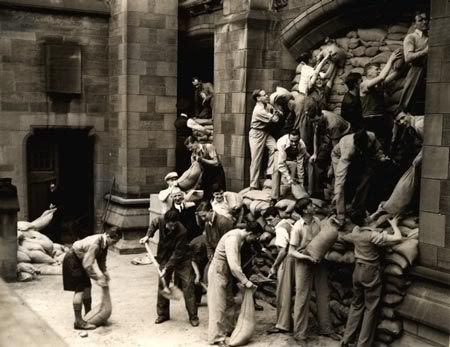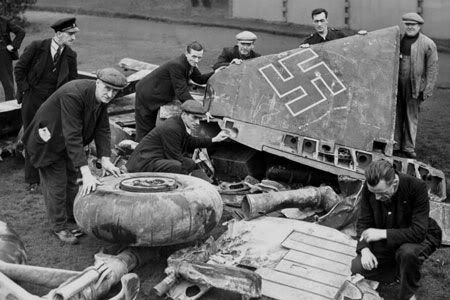Bombs over Glasgow in WW2
Moderators: John, Sharon, Fossil, Lucky Poet, crusty_bint, Jazza, dazza
Yeah Socceroo, I know th former Elgin Place church was lamp-blacked and never cleaned. I think the vast majority of the city must have been given the same treatment.
- crusty_bint
- -

- Posts: 4425
- Joined: Thu Jan 29, 2004 3:52 pm
- Location: Glasgow
Low Moss Prison just outside Bishopbriggs was originally a barrage ballon base and I'm sure I saw somewhere that the Kelvin Hall was used to manufacture them.
I always wondered why Elgin Street Church was so dirty looking, did the Mitchell Library and halls receive a similar paint scheme? In 1950's photographs they appear very dark.
I always wondered why Elgin Street Church was so dirty looking, did the Mitchell Library and halls receive a similar paint scheme? In 1950's photographs they appear very dark.
- JoeyCape
- First Stripe

- Posts: 53
- Joined: Thu May 05, 2005 12:03 am
- Location: Belle Isle Tech
Luftwaffe aerial photograph of Port Dundas power station.
The Port Dundas power station is the subject of this photograph but much of central Glasgow is also visible. Note the deep shadows cast by the tall buildings in the tight grid of the city centre compared to the Possil housing estate, to the north.

The Port Dundas power station is the subject of this photograph but much of central Glasgow is also visible. Note the deep shadows cast by the tall buildings in the tight grid of the city centre compared to the Possil housing estate, to the north.

-

HollowHorn - Third Stripe

- Posts: 8921
- Joined: Mon May 23, 2005 9:59 pm
- Location: Paisley
I'd like to find out more about this 'painting out' of buildings throughout Glasgow - mainly 'cos I'm not convinced of it (or the extent of it). I appreciate that this probably just means I've not found out about it 'till now.
My reasons for doubt are:
1) In a strategic-resources-shortages-stricken U.K. it would have been a huge redirection of manpower and materials (scaffolding etc. as well as paint and especially bitumen) at a critical point in the war. Especially if we are talking here about wholesale painting of buildings.
2) Glasgow was already a well soot-blackened city at the outbreak of war. I think it's difficult for anyone who grew up in post 60s Glasgow to visualise just how black and grimy the city was (hence the infamous description of Glasgow tenements at the time as 'rows of blackened rotten teeth)
I wonder if there is a wee bit of the wartime urban myth about this painting out? These myths were often stgrongly held, and sometimes 'officially' encouraged for morale reasons. Consequently, the perceptions and memories of folk can be genuine and sincere, even if a bit awry. For example, I could see blackening out of windows perhaps taking place in some major public buildings, or perhaps specific landmarks were disguised/blackened out - such work could have then generated perceptions of wholesale painting of buildings.
An example of a wartime 'encouraged' myth is that along the Edinburgh Road dual carriageway there were an undefined number of wooden crates deposited along the central reservation. The myth was that these were 'spare' fighter aircraft held in reserve should 'Gerry' be so daft as to actually land in Scotland. The reality was, of course, that we were desperately short of fighter aircraft and could not have afforded such a reserve.
I'd love to learn more about this painting out assertion. The great thing about HG is the search for authenticity - so I stand ready to learn more
My reasons for doubt are:
1) In a strategic-resources-shortages-stricken U.K. it would have been a huge redirection of manpower and materials (scaffolding etc. as well as paint and especially bitumen) at a critical point in the war. Especially if we are talking here about wholesale painting of buildings.
2) Glasgow was already a well soot-blackened city at the outbreak of war. I think it's difficult for anyone who grew up in post 60s Glasgow to visualise just how black and grimy the city was (hence the infamous description of Glasgow tenements at the time as 'rows of blackened rotten teeth)
I wonder if there is a wee bit of the wartime urban myth about this painting out? These myths were often stgrongly held, and sometimes 'officially' encouraged for morale reasons. Consequently, the perceptions and memories of folk can be genuine and sincere, even if a bit awry. For example, I could see blackening out of windows perhaps taking place in some major public buildings, or perhaps specific landmarks were disguised/blackened out - such work could have then generated perceptions of wholesale painting of buildings.
An example of a wartime 'encouraged' myth is that along the Edinburgh Road dual carriageway there were an undefined number of wooden crates deposited along the central reservation. The myth was that these were 'spare' fighter aircraft held in reserve should 'Gerry' be so daft as to actually land in Scotland. The reality was, of course, that we were desperately short of fighter aircraft and could not have afforded such a reserve.
I'd love to learn more about this painting out assertion. The great thing about HG is the search for authenticity - so I stand ready to learn more
- escotregen
- Third Stripe

- Posts: 1073
- Joined: Tue Jan 13, 2004 3:35 pm
- Location: glasgow
There was definitely blackening out of buildings with Lamp Black Escoty, i have actually been on projects in the late 80's - although only a couple it must be said where the stuff was evident - one in Glasgow and one in Hamilton, so like you i am looking to find out more about it.
Elgin Place Church as Crusty referred to, i am almost certain was not just soot and grime, i think it was generally recognised as being blacked out and then not cleaned following the war due to the poor state of it's stone.
I always thought war time resources would be a bit thin in Glasgow, but i continue to be surprised with what i find in my searches about the bombing of Glasgow and the elaborate measures that were put in place such as the number of AA guns, the early introduction of Z rockets, the number of barrage balloons, anti flood defences, deep Haldane Shelters, smoke screens and the city searchlight policy.
Remember, Glasgow was the "Second City" at the time of the war and had one of the largest heavy industry bases in Europe, probably only second to the Rhur in Germany. I have also found that the then Glasgow Lord Provost Patrick Dollan and his predeccessor, were quite far sighted about the war, in that Glasgow was preparing from 1936 onwards.
During this period 1936 - 1939 a lot of Committees were formed who had the use of quite large resources of manpower in peacetime Glasgow prior to men being called to arms. It would be possible therefore if it were policy, to paint out buildings fairly easily and quickly.
I do not know how widespread this practice of Lamp Black was but it would appear to be fairly widespread.
Saying that, the famous actor and writer, Dirk Bogarde, who stayed in Glasgow in the early 1930's as a schoolboy, referred to Glasgow in his biography as the "Anthracite City" due to it's pre war industrial tainted colour which had nothing to do with Lamp Black.
Elgin Place Church as Crusty referred to, i am almost certain was not just soot and grime, i think it was generally recognised as being blacked out and then not cleaned following the war due to the poor state of it's stone.
I always thought war time resources would be a bit thin in Glasgow, but i continue to be surprised with what i find in my searches about the bombing of Glasgow and the elaborate measures that were put in place such as the number of AA guns, the early introduction of Z rockets, the number of barrage balloons, anti flood defences, deep Haldane Shelters, smoke screens and the city searchlight policy.
Remember, Glasgow was the "Second City" at the time of the war and had one of the largest heavy industry bases in Europe, probably only second to the Rhur in Germany. I have also found that the then Glasgow Lord Provost Patrick Dollan and his predeccessor, were quite far sighted about the war, in that Glasgow was preparing from 1936 onwards.
During this period 1936 - 1939 a lot of Committees were formed who had the use of quite large resources of manpower in peacetime Glasgow prior to men being called to arms. It would be possible therefore if it were policy, to paint out buildings fairly easily and quickly.
I do not know how widespread this practice of Lamp Black was but it would appear to be fairly widespread.
Saying that, the famous actor and writer, Dirk Bogarde, who stayed in Glasgow in the early 1930's as a schoolboy, referred to Glasgow in his biography as the "Anthracite City" due to it's pre war industrial tainted colour which had nothing to do with Lamp Black.
-

Socceroo - Third Stripe

- Posts: 1369
- Joined: Thu Sep 08, 2005 8:51 pm
- Location: Mount Flo, Glasgow

Glasgow had some manpower resources during the war from a most unlikely source
The above photo shows a group of Glasgow Uni students filling and stacking sandbags at Gilmorehill in 1940.
The Kelvin Way bomb in 1942 which damaged the statues on the Kelvin Way bridge also shattered a fair amount of the south facing windows of the University a good distance away. The University was thought to be a fairly high risk target due to its prominent position on Gilmorehill.
During the war the University had a large voluntary group of staff and students who carried out ARP and fire watching duties on the campus and the surrounding west end.
As a wee aside, the University lost over 450 students and staff on active service during WWII which was an incredibly high percentage of their roll at that time.
-

Socceroo - Third Stripe

- Posts: 1369
- Joined: Thu Sep 08, 2005 8:51 pm
- Location: Mount Flo, Glasgow
You sure that those students in the photograph are repairing the damage as opposed to causing damage? I mean there's one of them 'students' in short trousers 
- escotregen
- Third Stripe

- Posts: 1073
- Joined: Tue Jan 13, 2004 3:35 pm
- Location: glasgow
Soccerroo an interesting wee aspect of your downed fighter photograph is the age profile of the guys around it. The only half-young looking one (glasses behind the wing) looks as though he possibly is uniformed and a member of the services? Presumably this is reflects that fact that so many younger men would have been called-up by then.
Just adding a slightly more contemporary incident to the ‘bombs over Glasgow’ theme, I was perusing some declassified 1960s military documents (as you do) and came across this on likely targets in the UK for USSR nuclear attack:
TOP SECRET
JOINT INTELLIGENCE COMMITTEE 1967 REVIEW
Annex A to COS 1929/2/11/67
“Probable Nuclear Targets in the United Kingdom: Assumptions for Planning”:
Para 1 (c) “Bases for Allied Nuclear Strike Forces”, Gareloch, Holy Loch, Rosyth all listed
Para 2. on “Major cites” 20 UK cities listed; top of the list is Glasgow
Nice to know that when the balloon went up Glasgow and Scotland would be in at the start

Just adding a slightly more contemporary incident to the ‘bombs over Glasgow’ theme, I was perusing some declassified 1960s military documents (as you do) and came across this on likely targets in the UK for USSR nuclear attack:
TOP SECRET
JOINT INTELLIGENCE COMMITTEE 1967 REVIEW
Annex A to COS 1929/2/11/67
“Probable Nuclear Targets in the United Kingdom: Assumptions for Planning”:
Para 1 (c) “Bases for Allied Nuclear Strike Forces”, Gareloch, Holy Loch, Rosyth all listed
Para 2. on “Major cites” 20 UK cities listed; top of the list is Glasgow
Nice to know that when the balloon went up Glasgow and Scotland would be in at the start
- escotregen
- Third Stripe

- Posts: 1073
- Joined: Tue Jan 13, 2004 3:35 pm
- Location: glasgow
escotregen wrote:Soccerroo an interesting wee aspect of your downed fighter photograph is the age profile of the guys around it. The only half-young looking one (glasses behind the wing) looks as though he possibly is uniformed and a member of the services? Presumably this is reflects that fact that so many younger men would have been called-up by then.
Just adding a slightly more contemporary incident to the ‘bombs over Glasgow’ theme, I was perusing some declassified 1960s military documents (as you do) and came across this on likely targets in the UK for USSR nuclear attack:
TOP SECRET
JOINT INTELLIGENCE COMMITTEE 1967 REVIEW
Annex A to COS 1929/2/11/67
“Probable Nuclear Targets in the United Kingdom: Assumptions for Planning”:
Para 1 (c) “Bases for Allied Nuclear Strike Forces”, Gareloch, Holy Loch, Rosyth all listed
Para 2. on “Major cites” 20 UK cities listed; top of the list is Glasgow
Nice to know that when the balloon went up Glasgow and Scotland would be in at the start
Not really surprising though, an industrial city surrounded by all of that military hardware would be very high upon anyones list of targets. Taking out the enemy's weapons and the means to manufacture more. i'm sure that near the top of our list of targets would have been Soviet cities of similar stature.
-

AlanM - Third Stripe

- Posts: 1827
- Joined: Wed Sep 07, 2005 8:59 am
- Location: Knightswood
Alanm yeah no doubt there was (were) a Soviet counterpart city (or cities).
Next time I'm chatting to Socceroo, I must find out about the possibilities of a ghoulish 'target city twinning' through the Scotland Russia Society
Next time I'm chatting to Socceroo, I must find out about the possibilities of a ghoulish 'target city twinning' through the Scotland Russia Society
- escotregen
- Third Stripe

- Posts: 1073
- Joined: Tue Jan 13, 2004 3:35 pm
- Location: glasgow
Rostov on the Don, in the North Caucasus region is twinned
with Glasgow
More info http://tinyurl.com/7myub
with Glasgow
More info http://tinyurl.com/7myub
"The nose of a mob is its imagination. By this, at any time, it can be quietly led." - Edgar Allan Poe
-

Pripyat - Third Stripe

- Posts: 1494
- Joined: Tue Jan 24, 2006 11:05 pm
- Location: Suburban Forest
Return to Hidden Glasgow Projects
Who is online
Users browsing this forum: No registered users and 14 guests


